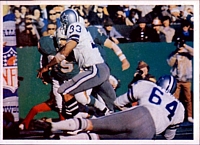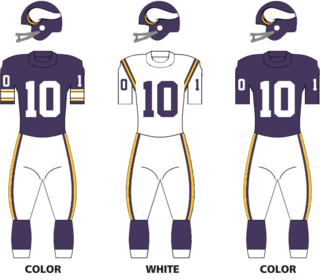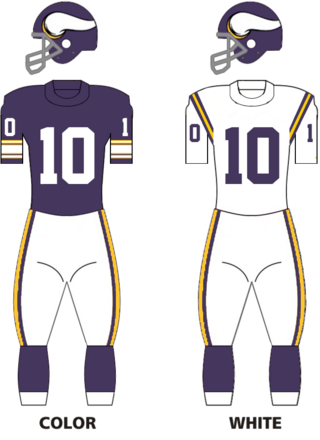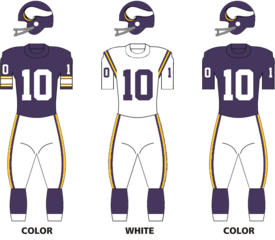Super Bowl VIII was an American football game between the National Football Conference (NFC) champion Minnesota Vikings and the American Football Conference (AFC) champion Miami Dolphins to decide the National Football League (NFL) champion for the 1973 season. The Dolphins conquered the Vikings by the score of 24–7 to win their second consecutive Super Bowl, the first team to do so since the Green Bay Packers in Super Bowls I and II, and the first AFL/AFC team to do so.

Super Bowl IX was an American football game played between the American Football Conference (AFC) champion Pittsburgh Steelers and the National Football Conference (NFC) champion Minnesota Vikings to decide the National Football League (NFL) champion for the 1974 season. The game was played on January 12, 1975, at Tulane Stadium in New Orleans, Louisiana. The Steelers defeated the Vikings by the score of 16–6 to win their first Super Bowl championship.

The National Football League playoffs for the 1971 season began on December 25, 1971. The postseason tournament concluded with the Dallas Cowboys defeating the Miami Dolphins in Super Bowl VI, 24–3, on January 16, 1972, at Tulane Stadium in New Orleans, Louisiana.
The National Football League playoffs for the 1973 season began on December 22, 1973. The postseason tournament concluded with the Miami Dolphins defeating the Minnesota Vikings in Super Bowl VIII, 24–7, on January 13, 1974, at Rice Stadium in Houston, Texas.
The National Football League playoffs for the 1974 season began on December 21, 1974. The postseason tournament concluded with the Pittsburgh Steelers defeating the Minnesota Vikings in Super Bowl IX, 16–6, on January 12, 1975, at Tulane Stadium in New Orleans, Louisiana.
The National Football League playoffs for the 1975 season began on December 27, 1975. The postseason tournament concluded with the Pittsburgh Steelers defeating the Dallas Cowboys in Super Bowl X, 21–17, on January 18, 1976, at the Orange Bowl in Miami.
The National Football League playoffs for the 1976 season began on December 18, 1976. The postseason tournament concluded with the Oakland Raiders defeating the Minnesota Vikings in Super Bowl XI, 32–14, on January 9, 1977, at the Rose Bowl in Pasadena, California.
The National Football League playoffs for the 1978 season began on December 24, 1978. The postseason tournament concluded with the Pittsburgh Steelers defeating the Dallas Cowboys in Super Bowl XIII, 35–31, on January 21, 1979, at the Orange Bowl in Miami.

The 2006 season was the Minnesota Vikings' 46th in the National Football League (NFL). Under new head coach Brad Childress, the team finished with a 6–10 record; however, they led the league in rushing defense, surrendering only 985 rushing yards; they are one of only two franchises in NFL history to allow fewer than 1,000 rushing yards in a 16-game season.

The 1969 season was the Minnesota Vikings' ninth season in the National Football League (NFL) and their third under head coach Bud Grant. With a 12–2 record, the best in the league, the Vikings won the NFL Central division title, to qualify for the playoffs for the second year in a row. This was the first of three consecutive seasons as the best team in the NFL for the Vikings. They beat the Los Angeles Rams in the Western Conference Championship Game, and the Cleveland Browns in the final NFL Championship Game before the merger with the American Football League. With these wins, the Vikings became the last team to possess the Ed Thorp Memorial Trophy, introduced 35 years earlier in 1934.

The 1973 season was the Minnesota Vikings' 13th in the National Football League (NFL). With a 12–2 record, the Vikings regained the NFC Central title after having gone 7–7 the previous year. They started the season 9–0 and looked a threat to the previous year's Miami Dolphins' record of a perfect season before losing to the Atlanta Falcons and Cincinnati Bengals in their next three games. Their narrow 10–9 win over the Los Angeles Rams constituted the last time until 1997 that the last two unbeaten NFL teams played each other.

The 1974 season was the Minnesota Vikings' 14th in the National Football League (NFL). They won the NFC Central with a 10–4 record, before defeating the St. Louis Cardinals 30–14 in the NFC divisional playoff game, followed by a 14–10 win over the Los Angeles Rams to claim their second consecutive NFC championship. The Vikings then lost 16–6 to the Pittsburgh Steelers in Super Bowl IX at Tulane Stadium in New Orleans, Louisiana, becoming the first team to lose consecutive Super Bowls.

The 1975 season was the Minnesota Vikings' 15th in the National Football League.

The 1976 season was the Minnesota Vikings' 16th in the National Football League (NFL). The Vikings finished with an 11–2–1 record to give them their eighth NFC Central division title. They beat the Washington Redskins 35–20 in the divisional round of the playoffs, followed by a 24–13 win over the Los Angeles Rams in the NFC Championship, before losing 32–14 to the Oakland Raiders in Super Bowl XI. As of 2023, this is the most recent Super Bowl appearance by the franchise.

The 1972 Miami Dolphins season was the franchise's seventh season and third in the National Football League (NFL). The team was led by third-year head coach Don Shula and achieved the only perfect season in NFL history. They also led the league in both points scored and fewest points allowed.
The 2010 Miami Dolphins season was the franchise's 41st season in the National Football League (NFL), the 45th overall and the third under head coach Tony Sparano. The Dolphins failed to improve upon their 7–9 record in 2009, and placed in third in the AFC East that year.

The 2010 season was the Minnesota Vikings' 50th in the National Football League (NFL), and the fifth and final under head coach Brad Childress. After a loss to the New Orleans Saints in the NFC Championship ended their 2009 season, the Vikings had hoped to defend their NFC North division title for the third year in a row and contend again for a Super Bowl championship. However, Brett Favre was unable to recover from the injuries he had sustained in the NFC Championship and turned in abysmal performances for most of the season, being forced to sit out three games due to injuries and breaking his consecutive start record at 297 games since September 1992. After the Vikings fell to a 3–7 record with a 31–3 division loss to the Green Bay Packers in week 11, Childress was fired and defensive coordinator Leslie Frazier was named as his interim replacement, going 3–3 in his six games in charge before taking over the job permanently at the end of the season. The team finished 6–10 and ended up in last place in the division for the first time since 1990.

The 2021 season was the Baltimore Ravens' 26th season in the National Football League (NFL) and their 14th under head coach John Harbaugh.

The 2022 season was the Miami Dolphins' 53rd in the National Football League (NFL), their 57th overall, the first under new head coach Mike McDaniel, and seventh under general manager Chris Grier. It also set out with the acquisition of 3x All-Pro receiver Tyreek Hill, who joined Jaylen Waddle as Tua Tagovailoa's receiving duo after breaking contract talks with the Chiefs and being traded in March.

The 2022 season was the Cleveland Browns' 70th in the National Football League (NFL), their 74th overall, and their third under the head coach/general manager tandem of Kevin Stefanski and Andrew Berry. The Browns failed to improve upon their 8–9 record from the previous season as they finished 7–10. The Browns failed to qualify for the playoffs for the second straight season The Browns introduced a new midfield logo, with Brownie the Elf; this is their first season with a new midfield logo since 2016.











